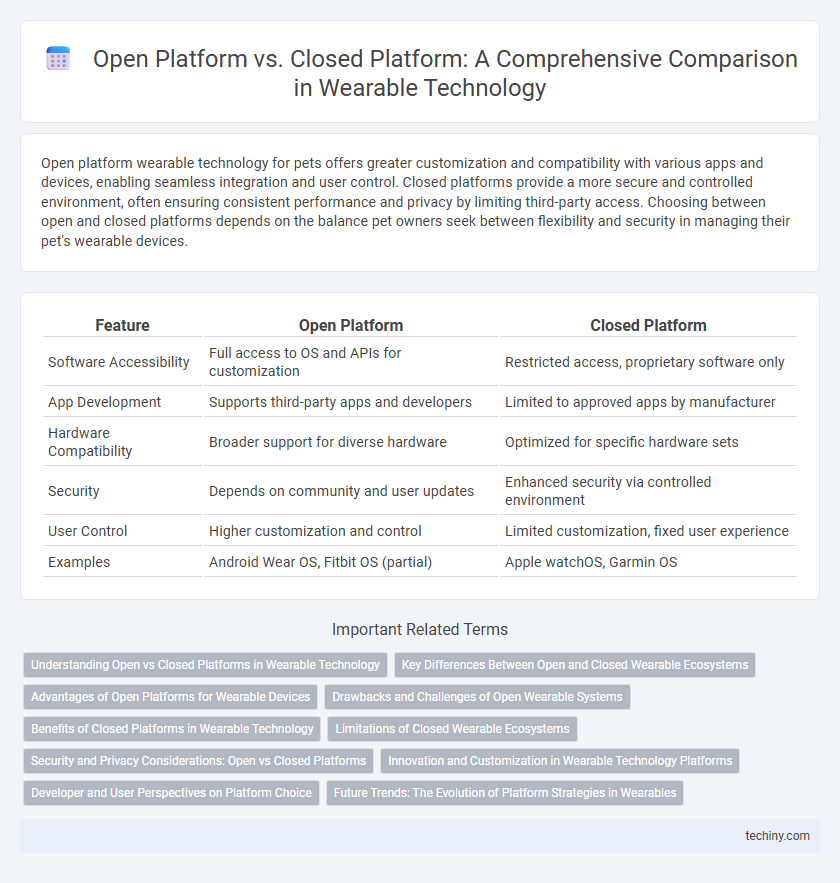Open platform wearable technology for pets offers greater customization and compatibility with various apps and devices, enabling seamless integration and user control. Closed platforms provide a more secure and controlled environment, often ensuring consistent performance and privacy by limiting third-party access. Choosing between open and closed platforms depends on the balance pet owners seek between flexibility and security in managing their pet's wearable devices.
Table of Comparison
| Feature | Open Platform | Closed Platform |
|---|---|---|
| Software Accessibility | Full access to OS and APIs for customization | Restricted access, proprietary software only |
| App Development | Supports third-party apps and developers | Limited to approved apps by manufacturer |
| Hardware Compatibility | Broader support for diverse hardware | Optimized for specific hardware sets |
| Security | Depends on community and user updates | Enhanced security via controlled environment |
| User Control | Higher customization and control | Limited customization, fixed user experience |
| Examples | Android Wear OS, Fitbit OS (partial) | Apple watchOS, Garmin OS |
Understanding Open vs Closed Platforms in Wearable Technology
Open platforms in wearable technology enable developers to access and modify software and hardware components, fostering innovation and customization through wider compatibility and third-party app integrations. Closed platforms restrict access to proprietary systems, enhancing security and ensuring consistent user experience but limiting flexibility and external development. Choosing between open and closed platforms balances trade-offs in control, adaptability, and ecosystem diversity critical for wearable device functionality and user engagement.
Key Differences Between Open and Closed Wearable Ecosystems
Open wearable ecosystems provide greater flexibility by allowing third-party app integrations and hardware compatibility, fostering innovation and customization. Closed platforms restrict access to proprietary software and hardware, ensuring tighter security and optimized performance but limiting user control and app variety. Key differences include levels of user freedom, developer access, security protocols, and the potential for ecosystem fragmentation.
Advantages of Open Platforms for Wearable Devices
Open platforms for wearable devices offer significant advantages including enhanced interoperability, allowing seamless integration with multiple hardware and software ecosystems. They encourage innovation by providing developers access to open APIs and extensive customization options, fostering a diverse app environment. Open platforms also facilitate faster software updates and community-driven improvements, optimizing device performance and user experience.
Drawbacks and Challenges of Open Wearable Systems
Open wearable systems face significant drawbacks such as interoperability issues and security vulnerabilities due to their open architecture, which can expose sensitive user data. Compatibility challenges arise from diverse hardware and software components, leading to inconsistent user experiences and increased development complexity. Furthermore, managing frequent updates and ensuring seamless integration with third-party applications often strain resources and complicate system maintenance.
Benefits of Closed Platforms in Wearable Technology
Closed platforms in wearable technology offer enhanced security by limiting software access and reducing vulnerabilities. They ensure optimized performance through tightly controlled hardware and software integration, resulting in better battery life and user experience. Proprietary ecosystems enable consistent updates and reliable customer support, fostering brand trust and loyalty.
Limitations of Closed Wearable Ecosystems
Closed wearable ecosystems restrict user customization and third-party app integration, limiting device functionality and innovation. Such platforms often enforce proprietary hardware and software compatibility, reducing consumer choice and hindering seamless interoperability across devices. This confinement can result in slower adoption of new technologies and diminished user engagement compared to open platforms.
Security and Privacy Considerations: Open vs Closed Platforms
Open platforms in wearable technology offer greater customization but pose higher security risks due to increased vulnerability to malware and unauthorized access. Closed platforms provide enhanced privacy controls and robust security through controlled app environments and strict data encryption protocols. Balancing usability and protection, closed systems typically ensure stronger compliance with regulatory standards such as GDPR and HIPAA.
Innovation and Customization in Wearable Technology Platforms
Open platforms in wearable technology foster greater innovation by allowing developers to create diverse applications and customize features tailored to user needs. Closed platforms, while offering streamlined experiences and enhanced security, limit the ability to innovate and personalize due to restricted access and proprietary controls. The choice between open and closed platforms directly impacts the pace of technological advancement and the level of customization available in wearable devices.
Developer and User Perspectives on Platform Choice
Open platforms in wearable technology offer developers extensive customization and integration capabilities, fostering innovation and allowing users to tailor experiences to specific needs. Closed platforms provide a more controlled environment that can enhance security and ensure a consistent user interface, appealing to those prioritizing reliability and simplicity. Developers often weigh the flexibility of open systems against the streamlined approval process of closed ecosystems, while users consider the trade-offs between customization and ease of use in their platform choice.
Future Trends: The Evolution of Platform Strategies in Wearables
Open platform strategies in wearable technology are driving innovation by enabling cross-device compatibility and fostering developer ecosystems through accessible APIs and SDKs. Closed platforms, while offering enhanced security and optimized performance, face challenges adapting to diverse user needs and integrating emerging technologies such as AI and 5G. Future trends indicate a hybrid platform evolution that balances openness for customization with closed system controls to ensure privacy and seamless user experiences.
Open Platform vs Closed Platform Infographic

 techiny.com
techiny.com